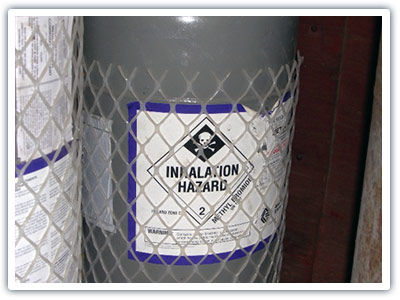Lesson 2: Types of Phytosanitary Treatments
Topic 1: Chemical Phytosanitary Treatments
In this topic, we will explore chemical phytosanitary treatments and how these treatments are applied.
Objectives:
- Participants will identify and explain the use of chemical phytosanitary treatments.
What is a chemical phytosanitary treatment?
Chemical phytosanitary treatments are pesticides that are made from compounds naturally occurring in plants or synthesized from chemical compounds. Pesticides play a key role in any pest management program. The major benefits of using pesticides are that they are highly effective, control pests quickly and easily, and are reasonably priced compared to other control options available. In most instances, pest damage stops or pests are killed in a few hours or days after the pesticide has been applied. Comparably, fungicides may provide immediate protection against microorganisms. Chemical phytosanitary treatments can often be used on their own, without other treatment measures, to achieve a required target level of pest control. The required target level of pest control for a treatment is also known as the efficacy of the treatment.

A pesticide is any material applied to plants, soil, harvested crops, crops that are growing, buildings, structures, containers, or solid wood packing materials that kills the pest or regulates or interrupts the growth and mating cycles of pests, or is applied to regulate plant growth in weeds. Pesticides consist of a wide variety of chemicals that have specialized names and uses. The following are a few examples:
- Insecticides control insects.
- Molluscicides control snails.
- Nematicides control nematodes.
- Growth regulators alter or change the growth or the development of a plant.
- Fungicides control fungi.

Fumigation is a chemical phytosanitary treatment in which a toxic chemical is released and dispersed, so it reaches the target organism in a gaseous state. The ideal fumigant would have the following characteristics:
- Highly toxic to the target pest
- Nontoxic to plants and vertebrates (including humans)
- Easily and cheaply generated
- Harmless to foods and commodities
- Inexpensive
- Nonexplosive
- Nonflammable
- Insoluble in water
- Nonpersistent (i.e., breaks down quickly to avoid accumulating in organisms)
- Easily diffuses and rapidly penetrates commodity
- Stable in the gaseous state (e.g., will not condense to a liquid)
- Easily detected by human senses
 The effectiveness of a fumigant in killing or neutralizing pests depends on a number of factors, including the host commodity (e.g., size shape, degree of ripeness), the pest (e.g., type of pest, life stage of the pest [i.e., egg, larvae, instar]), the dosage rate of the pesticide, the temperature, and the exposure time.
The effectiveness of a fumigant in killing or neutralizing pests depends on a number of factors, including the host commodity (e.g., size shape, degree of ripeness), the pest (e.g., type of pest, life stage of the pest [i.e., egg, larvae, instar]), the dosage rate of the pesticide, the temperature, and the exposure time.
Fumigants vary greatly in their mode of action. Some kill rapidly while others kill slowly. In sublethal dosages, some fumigants may have a paralyzing effects on the target pest, while others will not allow the pest to recover. Some fumigants have no effect on commodities, while others are detrimental even at low concentrations.

Pesticides commonly used to fumigate for pests in internationally traded agricultural commodities include:
- Methyl bromide (MB) for all insects and snails
- Sulfuryl fluoride (SF) for some wood boring insects and termites
- Phosphine (PH), which includes aluminum phosphide (AP) and magnesium phosphide (MP) for grain shipments that could be infested with storage pests
Benefits and Drawbacks to Methyl Bromide
Methyl bromide is widely used to treat internationally traded commodities because it is:
- effective on a broad spectrum of target organisms,
- well-tolerated by many host commodities,
- inexpensive, and
- relatively easy to use.
For example, methyl bromide is approved as a treatment for many fruits for consumption, grains and cereals, plants for planting, bagging material, and wood packing material. However, methyl bromide does have drawbacks.
- Methyl bromide can damage some perishable commodities such as stone fruits and bananas.
- Methyl bromide, as with other pesticides, can have negative human health and environmental effects.
- Methyl bromide depletes the ozone layer and was banned by the Montreal Protocol
The remaining permissible uses of methyl bromide are for quarantine and pre-shipment, fumigation for internationally traded agricultural commodities, and a few emergency uses. Even though methyl bromide is still widely used by many countries as a quarantine fumigant for agricultural commodities, the IPPC recommends that its member countries find ways to replace methyl bromide use and reduce methyl bromide emissions.
The IPPC recommends the following alternatives to methyl bromide fumigation where possible:
- Use other chemical treatments where possible (e.g. sulfuryl fluoride)
- Use physical treatments where possible (e.g. heating, cooling, irradiation), methyl bromide in situations where efficacy is doubtful or marginal.
- Use inspection-based fumigation rather than mandatory fumigation.
- Use optimal temperatures when fumigating.
- Reassess doses and exposure times to reduce them.
- Use appropriately sized treatment facilities.
The IPPC has published their recommendations to replace or reduce the use of methyl bromide as a phytosanitary measure.
The recommendations to replace, reduce volumes, reduce emissions, recording methyl bromide use, and guidelines for appropriate use may be found at this link:

In this topic, we explored the different types of chemical phytosanitary treatments. Chemical phytosanitary treatments use pesticides that are made from compounds naturally occurring in plants or that are synthesized from chemical compounds. Pesticides play a key role in any pest management program.
To continue, select Topic 2 from the Topics menu above or click here.